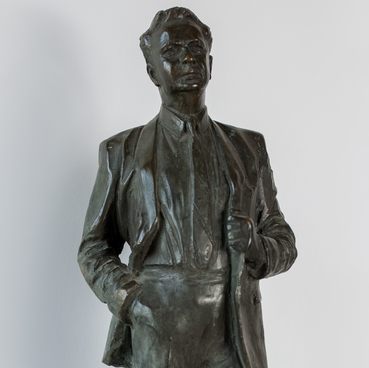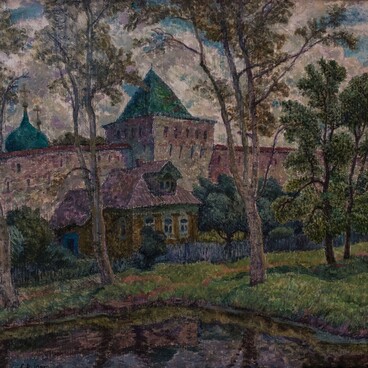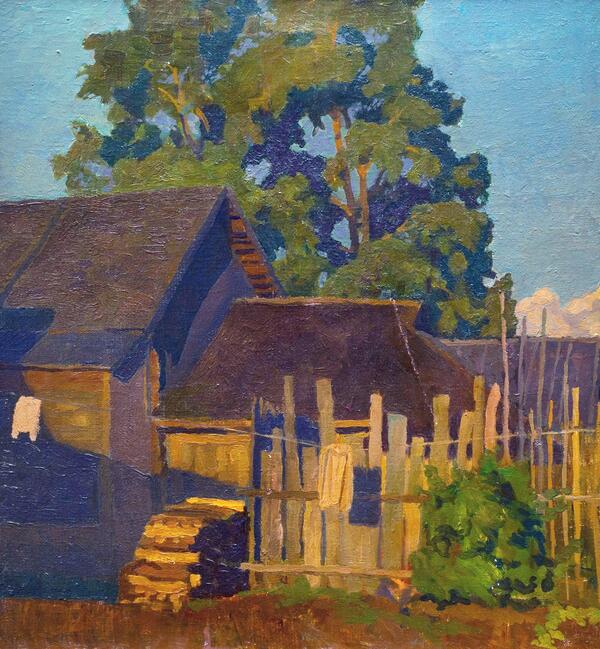Artist Vladimir Shcherbakov worked in genre painting and dedicated his artworks to everyday life of ordinary people. His works were devoid of political statements, they did not raise social issues and problems; they did not show dark events. The aesthetics of everyday life remained the most important thing for him.
In his painting “Haymaking Time”, Shcherbakov depicted a small group of peasants who stack hay — densely pack it, making haystacks. In the foreground on the left side, one can see a single bush, and on the right side — a wavy dug-up road recedes into the distance. In the background, the artist depicted village houses and trees in front of which drying grass is scattered on the lawn. A man and two women gather it in stacks behind the trees. Dark-green tree crowns with yellow spots indicate late summer and upcoming autumn.
The Russian word “senokos”, or “haymaking”, means preparing the hay to feed the livestock in the winter: the word referred to the actual process of cutting the grass, the time when it is done and the meadow where the grass was cut.
Peasants usually cut fresh grass, left it in the sun to let it dry, turning it over from time to time and then made haystacks. The best time for haymaking was considered from June 30 to July 12.
Haymaking was a festive time that people looked forward to: compared to other activities, haymaking was the most pleasant one. Usually, the entire locality or village came out to cut the grass together and then all the residents got their equal share of dry hay.
Artist Vladimir Shcherbakov was born on July 19, 1935 in Moscow. He studied at the Moscow Secondary Art School and then at the Surikov Moscow Art Institute. In 1991, Shcherbakov was awarded the title of People’s Artist of Russia.
Shcherbakov was a realist artist; he painted portraits and landscapes and created genre and thematic paintings. He used oil and watercolors for his works, lithography, a method of printing with a flat stone, and linocut — a printmaking technique, a type of woodcut.
From 1959 to 2014, Shcherbakov participated in many Moscow, republican, national, All-Russian and international art exhibitions. His works are housed in Russian and foreign museums and art galleries, especially in the Tretyakov Gallery, the Russian Museum, as well as in the Permanent Mission of the Russian Federation to the United Nations (Washington, the USA) and in some private collections in the USA, Canada, Australia, Japan and many others.
In his painting “Haymaking Time”, Shcherbakov depicted a small group of peasants who stack hay — densely pack it, making haystacks. In the foreground on the left side, one can see a single bush, and on the right side — a wavy dug-up road recedes into the distance. In the background, the artist depicted village houses and trees in front of which drying grass is scattered on the lawn. A man and two women gather it in stacks behind the trees. Dark-green tree crowns with yellow spots indicate late summer and upcoming autumn.
The Russian word “senokos”, or “haymaking”, means preparing the hay to feed the livestock in the winter: the word referred to the actual process of cutting the grass, the time when it is done and the meadow where the grass was cut.
Peasants usually cut fresh grass, left it in the sun to let it dry, turning it over from time to time and then made haystacks. The best time for haymaking was considered from June 30 to July 12.
Haymaking was a festive time that people looked forward to: compared to other activities, haymaking was the most pleasant one. Usually, the entire locality or village came out to cut the grass together and then all the residents got their equal share of dry hay.
Artist Vladimir Shcherbakov was born on July 19, 1935 in Moscow. He studied at the Moscow Secondary Art School and then at the Surikov Moscow Art Institute. In 1991, Shcherbakov was awarded the title of People’s Artist of Russia.
Shcherbakov was a realist artist; he painted portraits and landscapes and created genre and thematic paintings. He used oil and watercolors for his works, lithography, a method of printing with a flat stone, and linocut — a printmaking technique, a type of woodcut.
From 1959 to 2014, Shcherbakov participated in many Moscow, republican, national, All-Russian and international art exhibitions. His works are housed in Russian and foreign museums and art galleries, especially in the Tretyakov Gallery, the Russian Museum, as well as in the Permanent Mission of the Russian Federation to the United Nations (Washington, the USA) and in some private collections in the USA, Canada, Australia, Japan and many others.



